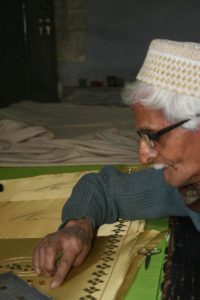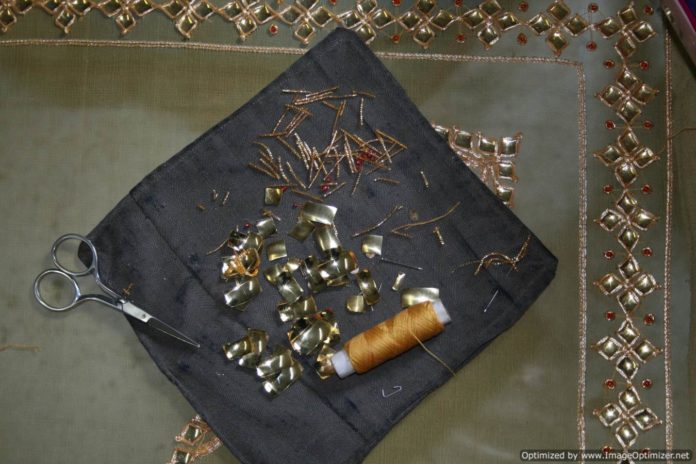In the kaarkhanas or workshops in Udaipur, Rajasthan, an unusual form of glittering ornamentation called danke-ka-kaam is embroidered onto textiles. The danka are small gold and silver square metal faceted discs, no bigger than 1.5 centimetres, that have been hand-beaten to form a facet that glints and reflects light akin to a diamond. The danka lies at the heart of the opulent embroidered ceremonial poshaks worn by Mewari Rajput women at weddings and festive rituals. This traditional garment comprises of a kanchali (blouse) ghagara (full length) gathered skirt and odhna (head) mantle. In the last few decades danka has also been embroidered onto saris and other garments.
 This specially commissioned luxury embroidery is worth its weight in gold. It uses the most basic of tools. There is the adda, the rectangular wooden frame on which the fabric is stretched for embroidery. And there are the stencils used to transfer the motifs—paisleys, flora and fauna to geometric patterns. A variety of needles, including the ari (the hooked needle), are used to ply the metallic yarns that are worked around the danka, which is couched onto opulent silks, satins and velvets.
This specially commissioned luxury embroidery is worth its weight in gold. It uses the most basic of tools. There is the adda, the rectangular wooden frame on which the fabric is stretched for embroidery. And there are the stencils used to transfer the motifs—paisleys, flora and fauna to geometric patterns. A variety of needles, including the ari (the hooked needle), are used to ply the metallic yarns that are worked around the danka, which is couched onto opulent silks, satins and velvets.
Danke-ka-kaam remains relatively unknown outside its own geography. Both the making of the danka pieces and its embroidery are practiced by the small Bohra Muslim community who migrated to this area in the sixteenth century and continue their traditional practice today. Saifuddin Zariwala is the senior most of the practitioners; he is the seventh generation of his family practising the craft. While a little over 25 persons are engaged in the embroidery, only Babu Bhai Qutubudin Zariwala and his daughter Sidhika Banu are the sole custodian of the skill of making the danka piece itself.





